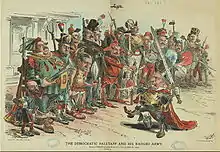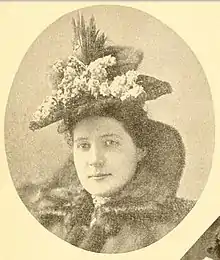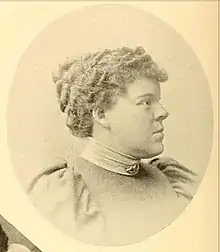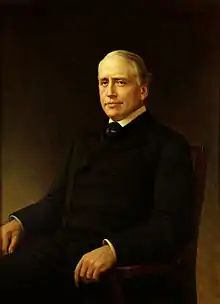Arthur Pue Gorman
Arthur Pue Gorman (March 11, 1839 – June 4, 1906) was an American baseball player and politician. He served as United States Senator from Maryland from 1881 to 1899 and again from 1903 until his death. He was a prominent leader of the Bourbon Democrat faction of the Democratic Party.
Arthur Pue Gorman | |
|---|---|
 | |
| Chairman of the Senate Democratic Caucus | |
| In office March 4, 1903 – June 4, 1906 | |
| Preceded by | James Kimbrough Jones |
| Succeeded by | Joseph Clay Stiles Blackburn |
| In office May 3, 1890 – April 1898 | |
| Preceded by | James B. Beck |
| Succeeded by | David Turpie |
| United States Senator from Maryland | |
| In office March 4, 1903 – June 4, 1906 | |
| Preceded by | George Wellington |
| Succeeded by | William Pinkney Whyte |
| In office March 4, 1881 – March 3, 1899 | |
| Preceded by | William Pinkney Whyte |
| Succeeded by | Louis E. McComas |
| Member of the Maryland Senate | |
| In office 1875 – 1881[1] | |
| Member of the Maryland House of Delegates | |
| In office 1869 – 1875[1] | |
| Personal details | |
| Born | March 11, 1839 Woodstock, Maryland, U.S. |
| Died | June 4, 1906 (aged 67) Washington, D.C., U.S. |
| Resting place | Oak Hill Cemetery (Washington, D.C.) |
| Political party | Democratic |
| Spouse(s) | Hannah "Hattie" Donagan
(m. 1867) |
| Children | 6 |
| Relatives |
|
As a young man, Gorman was a founding member of the original Washington Nationals of the National Association, the first American baseball team, and became one of the nation's star players by 1864. Later in life, he served as a member of the Mills Commission which investigated the origins of the sport.[2]
Early life and career
Gorman was born in Woodstock, Maryland on March 11, 1839. His father was Peter Gorman, a prominent Maryland businessman, and his mother was Elizabeth A. Gorman (née Brown). Arthur was named after the family physician, Dr. Arthur Pue. He was the first of five children, including William.[2]
Gorman's paternal grandfather, John, emigrated to the U.S. from Ireland circa 1794, first settling in Harrisburg, Pennsylvania before moving to the Baltimore area.[2]
The Gorman family moved to Laurel, Maryland in 1848, where they owned a 150-acre (61 ha) farm.[2][3][4] Because there were no public schools in Laurel, Peter Gorman hired a succession of tutors for his son.
In 1850, Peter Gorman (through his connections to Maryland Congressmen William T. Hamilton and Edward Hammond) arranged for 11-year old Arthur to serve as a U.S. Senate page.[2] Gorman became friends with prominent Illinois Senator Stephen A. Douglas, who made Gorman his private secretary.[2] Gorman subsequently served the U.S. Senate in various offices as page, messenger, Assistant Doorkeeper, Assistant Postmaster, and finally Postmaster.[5]
In September 1866, Gorman was removed from his Senate Office of Postmaster and was immediately appointed Collector of Internal Revenue for the Fifth Congressional District of Maryland.[2]
Baseball
At the age of 20 in 1859, Gorman was one of the founding members of the Washington Nationals, the first official baseball team in America. He rose to become a star by the end of the Civil War era.[6]
In 1867, he led the Nationals in their first trip westward over the mountains, in which they beat every midwest team except Rockford, Illinois, which had Albert Spalding as its pitcher.[7] Also in 1867, Gorman was elected to a one-year term as president of the National Association of Base Ball Players.[2][7]
In February 1903, Gorman and his son-in-law Wilton Lambert attempted but failed to buy the Washington Senators baseball team.[2]
Early political career
Gorman was elected to the Maryland House of Delegates in 1869, serving until 1875; he served as Speaker of the House for one session.
Gorman was closely aligned with Baltimore political leader Isaac Freeman Rasin and supported William Pinkney Whyte for Governor in 1871. Whyte, in turn, gave Gorman a position as director of the C&O Canal.[8]
In 1875, he was elected to the Maryland State Senate, serving until 1881.[5]
U.S. Senator
In 1880, the Maryland legislature elected Gorman to the United States Senate, where he soon became a leader of the Bourbon Democrats. The New York Times reported that the previous legislative election was influenced by large groups of "ward rounders" who shot and wounded black Republican voters at the Howard County polls.[9]
_issued_by_Duke_Sons_%2526_Co._to_promote_Honest_Long_Cut_Tobacco_MET_DPB873736.jpg.webp)
In 1884, Gorman actively supported Grover Cleveland's presidential campaign.[11]
He served as the Democratic caucus chairman from 1890 to 1898. He chaired the Committee on Printing (53rd Congress) and served on the Committee on Private Land Claims (55th Congress).[5]
He played a major role in financial and tariff legislation, especially the Wilson-Gorman Tariff of 1894, which successfully lowered tariffs in response to the McKinley Act of 1890, but thwarted President Cleveland's effort at completely or nearly free trade.
Gorman was reelected twice more in 1886 and 1892 but was defeated for re-election in 1898, losing to Louis E. McComas.[5] After his defeat, Gorman campaigned for Maryland's other U.S. Senate seat and was elected again by the Legislature in 1902.[5][12] He was again appointed as the Democratic Caucus Chairman, which he held from 1903 to 1906.[5]

Gorman was briefly a candidate for U.S. President in 1892 and 1904.[13]
Racial politics
In 1889, Gorman sought to differentiate his party from a growing mixed-race coalition of Republicans and independent Democrats. He was quoted as saying, "We have determined that this government was made by white men and shall be ruled by white men as long as the republic lasts."[14]
In his final years, Gorman "spearheaded an attempt by Democrats to disenfranchise black voters in Maryland, who tended to vote Republican." Related legislation passed easily in the Democratically controlled Senate of early 1904, though Governor Warfield did not sign the bill into law, and it was rejected by voters in late 1905.[15]
Personal life and family
Gorman married a widow, Hannah "Hattie" Donagan, on March 28, 1867. They had five daughters and one son.[2]
Gorman served as a director and eventually president of the Chesapeake & Ohio Canal Company;[15] the canal ran along the north shore of the Potomac River from Georgetown above Washington, D.C. to Cumberland, Maryland.
In 1890, Gorman's wife and daughter Grace escaped a fire at their Laurel house "Fairview"; a new Queen Anne style house was built in its place the following year.[16][17][18]
Haddie Gorman Gambrill

Gorman's eldest daughter, Haddie, married Stephen Warfield Gambrill in 1900.[19] Her husband later served as a Maryland State Delegate, State Senator, and U.S. Representative.[20]
Ada Gorman

Gorman's daughter Ada married Charles Joseph Magness, a young man about half her age against her family's wishes in 1908.[21][22][23] Magness was soon thereafter imprisoned for desertion from the U.S. Navy. Upon his release a year later, the couple lived in Washington, D.C., and then the Baltimore suburb of Lutherville.[24]
When her mother died in 1910, Ada was cut off from her share of the Gorman family estate.[25] The marriage lasted a total of 14 years before Ada divorced in 1922 due to her husband's infidelity.[24][26] She died childless and with few friends in the spring of 1950.[24]
Grace "Daisy" Gorman Johnson
Gorman's daughter Grace (better known as Daisy) married Richard Alward Johnson, the first manager of the Laurel race track and later a Maryland State Senator, in 1895.[27] They had two children, Richard Jr. and Grace. They lived at the historic Overlook farmhouse in North Laurel, which was built for Daisy on the family property in 1911.[28] The town of Daisy in Howard County, Maryland is named in her honor.Richard Jr. raised and trained horses. Grace Johnson later married Braxton Bragg Comer Jr., son of former Alabama Governor B. B. Comer.[29][30][31]
Arthur Gorman Jr.
Gorman's only son, Arthur Jr., attended Lawrenceville Prep and played on the Maryland Agricultural College football team in 1892 and 1893 as a fullback.[32] In 1898, Arthur Jr. founded the Piedmont Mining Company in Maryland and West Virginia with his uncle William and Thomas L. Marriott.[33] He married Grace Norris on November 28, 1900.[34] Arthur Jr. served as a Maryland State Senator (1904–1910), the last year during which he was Senate President.[35]
Arthur Jr. was nominated for Governor of Maryland in 1911, but narrowly lost to Republican Phillips Lee Goldsborough.[36][37] He was later a State Tax Commissioner, until his death in 1919 due to complications from diabetes.[38][39]
Bessie Gorman Lambert
Gorman's daughter Bessie married Princeton graduate and Democratic speechwriter Wilton J. Lambert on June 24, 1896, at the Gormans' Washington home on the corner of 15th and K Streets.[40][41][42] They had two children, Elizabeth (b. 1897) and Arthur.[43] An attorney, Lambert helped Arthur Gorman attempt to buy the Washington Senators baseball team in February 1903.[2] His son, Arthur Gorman Lambert (1899–1991), was a member of Princeton's class of 1922, also practiced law, and founded Suburban Hospital in Bethesda, Maryland;[44] he unveiled a donated portrait of his grandfather, Arthur Pue Gorman, at the Capitol in 1943.[45]

Mary Gorman Hills
Gorman's youngest daughter, Mary, married Ralph Warren Hills on February 27, 1901.[46] Their son, Ralph Gorman Hills, won a bronze medal for shot put at the 1924 Summer Olympics.[47][48] He graduated from Princeton University, after which he earned an M.D. degree from Johns Hopkins University and became a doctor;[49] his first son, J. Dixon Hills,[50] also chose to become a physician.[47]
Gorman's great-grandson, Ralph Warren Hills Jr., was a WBAL television producer in Baltimore.[50][51][52][53]
Death and legacy
Gorman served as a U.S. senator until his death from a heart attack in Washington, D.C. on June 4, 1906.[15] He had been ill with stomach trouble and hadn't left his Washington house since mid-January.[13][54]
Legacy
Gorman, Maryland and Gormania, West Virginia, are named after him,[55] as is Gorman Road in North Laurel.[56] An elementary school near this road is named "Gorman Crossing".[56]
The repair ship USS Tutuila was originally named SS Arthur P. Gorman in August 1943.[57]
In 2000, a proposed neighborhood within the Kings Contrivance section of Columbia, Maryland was to be named "Gorman's Promise," but the naming was canceled after consideration of Gorman's involvement in the disenfranchisement of black voters.[58]
References
- Walter E. Arps, Jr. (November 2004). Maryland Mortalities 1876–1915 from the (Baltimore) Sun Almanac. Heritage Books. p. 93. ISBN 978-1585492541.
- Brian McKenna. "Arthur Gorman". SABR Baseball Biography Project. Society for American Baseball Research. Retrieved August 25, 2013.
- Gates, Merrill E. (1905). Men of Mark in America. Washington: Men of Mark. p. 392. Retrieved November 6, 2009.
- Official Congressional Directory. Washington: Government Printing Office. 1904. p. 44. Retrieved November 6, 2009.
- "GORMAN, Arthur Pue". Biographical Directory of the United States Congress. U.S. House of Representatives. Retrieved August 26, 2013.
- Povich, Shirley (1954). The Washington Senators. G.P. Putnam's Sons. pp. 3–4.
- Brady, James H. (Summer 1992). "Play Ball! The Legacy of Nineteenth-Century Baltimore Baseball" (PDF). Vol. 87 no. 2. Maryland Historical Society. pp. 11–12 (129–130). Retrieved May 26, 2018. Cite magazine requires
|magazine=(help) - Richardson Dilworth. Cities in American Political History. p. 318.
- "Maryland-Colored voters shot down and driven away from the polls" (PDF). The New York Times. November 5, 1879. Retrieved September 24, 2013.
- "Guide to the W. Duke, Sons & Co. Records and Advertising Materials, 1876-1953". Duke University Libraries. Retrieved February 23, 2018.
- Maryland A History of Its People. p. 207.
- Lambert, John R. Jr. (June 1963). "The Autobiographical Writings of Senator Arthur Pue Gorman" (PDF). Maryland Historical Magazine. Vol. 58 no. 2. p. 13 (103). Retrieved May 26, 2018.
- "Gorman Dies Suddenly; Was Seemingly Better" (PDF). The New York Times. June 5, 1906. Retrieved August 31, 2013.
- "Integrating the Maryland School of Law" (PDF). Maryland Historical Magazine: 42. Spring 1989.
- "Arthur Pue Gorman (1839–1906)". Maryland State Archives. Retrieved August 26, 2013.
- "Senator Gormans Loss". The Morning Herald. December 19, 1890. p. 11.
- "A Fine Mansion Burned" (PDF). New York Times. December 17, 1890. Retrieved August 30, 2013.
- "Home of Mr. Gorman. The Burned House at Laurel, MD, to be Replaced". Los Angeles Herald. September 3, 1891. p. 10. Retrieved August 30, 2013.
- "Obituaries". Morning Herald. Hagerstown, Maryland. March 28, 1923. p. 1.
- United States Congress. "Stephen Warfield Gambrill (id: G000035)". Biographical Directory of the United States Congress. Retrieved September 1, 2013.
- "From Washington". Alexandria Gazette. October 22, 1908. p. 2.
Magness was born of humble parents in Baltimore in 1885.
- "Deserter Magness Torn from Daughter of Late Senator Gorman". Washington Post. October 22, 1908. p. 1.
Magness is 22 years old according to the record of his enlistment while Mrs. Magness is said to be 38 years old.
- "Hold As Deserter Gorman's Relative" (PDF). New York Times. October 22, 1908. Retrieved September 1, 2013.
Magness is 23 years of age, according to the record of his enlistment
- Coughlin, Gene (July 23, 1950). "Lost Love of the Senator's Daughter". The American Weekly magazine. The Milwaukee Sentinel. p. 7. Retrieved September 1, 2013.
- "Gorman Daughter Rebuked in Will". The Washington Herald. Library of Congress. July 7, 1910. Retrieved September 1, 2013.
The will of Mrs. Hannah D. Gorman, widow of the late senator Arthur P. Gorman, which was filed in the Probate Court yesterday afternoon, cuts off Ada Gorman Magness, who, against the will of her mother and family, married Charles Magness, a musician in the Marine Corps.
- "Mrs. Magness Asks Decree" (PDF). New York Times. August 4, 1922. Retrieved September 1, 2013.
Mrs. Magness says that since Jan. 1, 1921, her husband has been guilty of infidelity on divers occasions.
- "Overlook (Kingdon Gould) House" (PDF). Retrieved August 23, 2013.
- Kelly, Jacques (January 19, 2018). "Kingdon Gould Jr., former ambassador and astute parking lot investor, dies at 94". The Baltimore Sun. Retrieved May 26, 2018.
- "Braxton Comer Jr. Dies in Alabama". Sarasota Herald-Tribune. April 27, 1954. p. 10. Retrieved December 22, 2013.
- "Social News". The Anniston Star. June 8, 1942. p. 3.
Mrs. Frank Willis Comer of Eufaula announces the engagement of her daughter, Annie Laurie, to Richard Johnson Comer of Glennville Plantation
- "Johnson-Comer Engagement" (PDF). The New York Times. March 15, 1918. Retrieved December 27, 2013.
- Morris Allison Bealle, Kings of American Football: The University of Maryland, 1890–1952, p. 16, Columbia Publishing Co., 1952.
- "Mining Company Incorporated". The Washington Post. 13 March 1898. p. 3.
- "Social and Personal". The Evening Times. Washington, D.C.: Library of Congress. November 9, 1900. Retrieved August 30, 2013.
- "Arthur P. Gorman, Jr". Maryland State Archives. April 30, 2010. Retrieved August 30, 2013.
- "Commentary: Right time, right place for Lee". The Daily Record. Baltimore: via HighBeam (subscription required). January 19, 2012. Archived from the original on June 11, 2014. Retrieved August 30, 2013.
- "Historical List" (PDF). Maryland State Archives. Retrieved August 30, 2013.
- "Arthur P. Gorman Dies in Hospital". The Washington Times. Library of Congress. September 4, 1919. Retrieved September 1, 2013.
- Maryland. General Assembly. Senate (1920). "Senate Resolution to the Memory of Hon. Arthur P. Gorman". Journal of Proceedings. pp. 250–252. Retrieved August 31, 2013.
- "Lambert–Gorman" (PDF). New York Times. June 25, 1896. Retrieved September 1, 2013.
- Smith, Frank Charles; Proctor, Lucien Brock; Chapin, Heman Gerald; Harvey, Richard Selden, eds. (1896) [Digitized June 16, 2010]. The American Lawyer. 4. Stumpf & Steurer. p. 318.
The ceremony was performed at 6.30 o'clock at the spacious home of Senator and Mrs. Gorman, corner of 15th and K streets.
- Princeton University Class of 1892 (1907). Quindecennial Record of the Class of Ninety-two of Princeton University. New York: Grafton Press. p. 12.
have taken considerable interest and done considerable work in the line of political speech-making in Maryland on behalf of the Democratic party
- Princeton University Class of 1892 (1907). Quindecennial Record of the Class of Ninety-two of Princeton University. New York: Grafton Press. p. 11. Retrieved September 6, 2013.
- "Arthur Gorman Lambert '22". Princeton Alumni Weekly. Princeton University Class of 1922. December 4, 1991. Archived from the original on September 27, 2013. Retrieved September 6, 2013.
- "Arthur P. Gorman". www.senate.gov. United States Senate. Retrieved September 6, 2013.
- Lex talionis; an analysis of the forces whose resultant produced the Treaty of Versailles. Baltimore, Maryland: Fleet-McGinley. 1922. Retrieved September 7, 2013.
- Howard, John Eager, M.D. (1979). "Memorial: Ralph Gorman Hills". Transactions of the American Clinical and Climatological Association. National Institutes of Health United States National Library of Medicine. 90: xli–xlii. PMC 2279394. PMID 390815.
- "Ralph Warren Hills". ancestry.com. Retrieved August 31, 2013.
- "Ralph Hills Bio, Stats, and Results". Sports Reference. Archived from the original on April 17, 2020. Retrieved August 31, 2013.
- Sentementes, Gus G. (June 17, 2012). "Obituary for Ralph Warren Hills, long-time television producer for WBAL-TV". Baltimore Sun. Retrieved August 31, 2013.
- "Ralph Warren Hills '61". Princeton Alumni Weekly. 113 (7). February 6, 2013. Retrieved August 31, 2013.
- "News Archive – 2012". Princeton University Class of 1961. Archived from the original on June 12, 2013. Retrieved August 31, 2013.
- "Ralph Warren "Hillsy" Hills". Hyde Bay Camp website. John Mercer. Retrieved September 8, 2013.
- Missy Burke; Robin Emrich; Barbara Kellner. Oh, You must live in Columbia. p. 55.
- Albert L. Feldstein (2006). Garrett County. Arcadia. p. 78. ISBN 9780738542669.
- Libit, Howard (July 10, 1997). "Board approves names for 2 new elementaries Schools in North Laurel, Glenelg to open next year". Baltimore Sun. Retrieved September 12, 2013.
- "Tutuila II". Dictionary of American Naval Fighting Ships. Department of the Navy – Naval History and Heritage Command. Retrieved February 22, 2018.
- Atwood, Liz (March 17, 2000). "Rouse Co. backtracks on neighborhood name". Baltimore Sun. Retrieved August 26, 2013.
Bibliography
- Lambert, John R. Arthur Pue Gorman (1953), the standard scholarly biography
- United States Congress. "Arthur Pue Gorman (id: G000326)". Biographical Directory of the United States Congress.
- Arthur Pue Gorman, late a senator from Maryland, Memorial addresses delivered in the House of Representatives and Senate frontispiece 1907
| Political offices | ||
|---|---|---|
| Preceded by Ferdinand Claiborne Latrobe |
Speaker of the Maryland House of Delegates 1872 |
Succeeded by Jesse K. Hines |
| U.S. Senate | ||
| Preceded by William Whyte |
U.S. Senator (Class 1) from Maryland 1881–1899 Served alongside: James Groome, Ephraim Wilson, Charles Gibson, George Wellington |
Succeeded by Louis E. McComas |
| New office | Chair of the Senate District of Columbia Corporations Committee 1892–1893 |
Succeeded by Nelson W. Aldrich |
| Preceded by Charles F. Manderson |
Chair of the Senate Printing Committee 1893–1895 |
Succeeded by Eugene Hale |
| Preceded by Isham G. Harris |
Chair of the Senate Private Land Claims Committee 1898 |
Succeeded by James Kimbrough Jones |
| Preceded by George Wellington |
U.S. Senator (Class 3) from Maryland 1903–1906 Served alongside: Louis E. McComas, Isidor Rayner |
Succeeded by William Whyte |
| Party political offices | ||
| Preceded by James B. Beck |
Chair of the Senate Democratic Caucus 1890–1898 |
Succeeded by David Turpie |
| Preceded by James Kimbrough Jones |
Chair of the Senate Democratic Caucus 1903–1906 |
Succeeded by Joseph Clay Stiles Blackburn |
